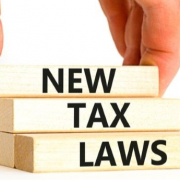Big Beautiful Bill Tax Changes By Income Bracket: Who Gains And Who Loses?
The “Big Beautiful Bill“—officially known as the One Big Beautiful Bill Act—has sparked intense political debate.
Marketed as a populist tax-and-spend initiative that locks in Trump-era cuts while delivering relief to everyday Americans, the bill actually brings sweeping structural changes with uneven effects across income levels.
An analysis by The Providence Journal and USA Today paints a mixed picture: some households see notable benefits, while others—especially lower-income families—may come out behind.
Breakdown by Income Bracket:
High-Income Households ($217,000 and up)
The wealthiest Americans are set to gain the most. According to the Tax Policy Center, over two-thirds of the bill’s tax relief flows to those earning more than $217,000 annually. In 2026, this group could receive average tax cuts of around $2,800.
Additional advantages include:
- A near doubling of the estate tax exemption (now protecting inheritances up to $14–15 million)
- An increased SALT deduction cap, rising from $10,000 to between $30,000–$40,000—a key win for high earners in states with steep taxes
Upper-Middle Income Earners ($100,000–$200,000)
This group also sees gains, though less dramatic. Benefits include:
- A modest increase in the child tax credit (to $2,200)
- Expanded SALT deductions
However, the Economic Times notes that 57% of all tax relief is concentrated among households earning over $217,000, leaving this group with a smaller share and less pronounced gains.
Middle-Class Households (Under $100,000)
The bill offers middle-income families mixed outcomes. Positive changes include:
- Elimination of federal taxes on tip and overtime earnings
- Temporary deductions on interest for American-made auto loans (up to $10,000)
Still, the overall financial benefit is limited. Households earning between $51,000 and $92,900 will see an average tax cut of just $815 per year. Those earning less will receive even smaller savings.
Lower-Income Households (Under $50,000)
This group is projected to lose the most under the new legislation. Annual losses range from $700 to $1,000, primarily due to:
- Reductions in Medicaid and SNAP (food stamps)
- Stricter work requirements that the Congressional Budget Office (CBO) warns could result in 7–10 million Americans losing Medicaid coverage
- Tighter eligibility for the child tax credit, which now requires a Social Security number for each child—a change that could affect up to 4.5 million families, according to The Providence Journal
Winners and Losers: A Summary
The Big Beautiful Bill delivers the most generous benefits to high-income Americans through:
- Permanent Trump-era tax cuts
- A higher SALT cap
- Expanded child tax credits
- New deductions for tip income, overtime, and car loan interest
However, these gains come at the cost of cuts to safety net programs. Medicaid and SNAP face deep reductions, putting millions at risk of losing healthcare or food assistance.
Additionally:
- Medicaid’s new work requirements could disenfranchise many low-income individuals
- Student loan relief is curtailed, with several programs eliminated and repayment options narrowed
- Clean energy tax incentives are rolled back, while fossil fuel industries retain their benefits—reflecting a shift away from climate priorities in favor of entrenched corporate interests
Source: MARCA





